Yogyakarta is a city that is always praised for its culture and fine arts. However there is another aspect to Yogyakarta that should not be left out. Yogyakarta offers a wide array of culinary delicacy. There are so many traditional food that the city has created. Below are 25 Traditional Food of Yogyakarta. Read on to find out what they are.
Read more:
1. Tiwul
 Tiwul is a very traditional food of Yogyakarta that has become popular in other cities too. Tiwul is made from pounding cassava and then drying it afterwards. The cassava is then called as gaplek.
Tiwul is a very traditional food of Yogyakarta that has become popular in other cities too. Tiwul is made from pounding cassava and then drying it afterwards. The cassava is then called as gaplek.
The pounded cassava is steamed with brown sugar already added to it. The steaming ends when it is fully cooked. Young, grated coconut is added on top of it making it taste a bit savoury.
2. Jadah Tempe
 Jadah Tempe consists of two kinds of food. The first one is made from rice that has been pounded and molded. The second one is tempe bacem. Tempe bacem is tempeh that is marinaded for hours with a lot of spices and sugar.
Jadah Tempe consists of two kinds of food. The first one is made from rice that has been pounded and molded. The second one is tempe bacem. Tempe bacem is tempeh that is marinaded for hours with a lot of spices and sugar.
After being marinaded, the tempeh is usually fried. The result is sweet and savoury tempeh. Both of those food are eaten together. Sometimes the tempe bacem is replaced with tofu.
Also read: Famous Indonesian Food
3. Bakpia Pathok
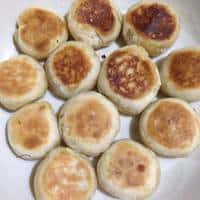 The name Pathok comes from a place in Yogyakarta where the food was first made. Bakpia Pathok is a rounded cake roll that is often small.
The name Pathok comes from a place in Yogyakarta where the food was first made. Bakpia Pathok is a rounded cake roll that is often small.
Inside the cake roll there is mung beans. The mung beans are already cooked and pounded until they become soft enough as a filling.
Other fillings for Bakpia Pathok also include cheese or chocolate. This traditional food is very popular and sold at many shops all over the city. It is so popular that a lot of people would buy this food as souvenirs.
Read: Famous Food of Indonesia
4. Cethil
 Cethil is a traditional food that is made from sago flour. Food colouring is often mixed into the flour to make Cethil looks colourful. The texture of Cethil is chewy and the taste is sweet. Cethil is often served inside a small, banana leaf. Grated coconut is added to Cethil.
Cethil is a traditional food that is made from sago flour. Food colouring is often mixed into the flour to make Cethil looks colourful. The texture of Cethil is chewy and the taste is sweet. Cethil is often served inside a small, banana leaf. Grated coconut is added to Cethil.
Also read: Street Food in Jakarta
The savoury coconut balances out the sweet flavour from Cethil. Cethil is usually sold inside traditional markets of Yogyakarta.
Read more: Street Food in Bandung
5. Yangko
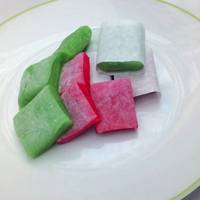 Yangko is mainly made from glutinous rice flour. The Yangko that is already made is also covered in bits of the glutinous rice flour. The flavour of this food is sweet. As for the texture, it’s chewy. Sometimes it is compared to the Japanese food, mochi.
Yangko is mainly made from glutinous rice flour. The Yangko that is already made is also covered in bits of the glutinous rice flour. The flavour of this food is sweet. As for the texture, it’s chewy. Sometimes it is compared to the Japanese food, mochi.
The shape of Yangko is square and small. Inside the Yangko, there is peanut filling. The filling for Yangko can be fruity too such as strawberry or melon. Yangko can be found in most food shops in Yogyakarta.
Read more: Street Food in Bali
6. Gatot
 Gatot is a traditional food that originated from Gunung Kidul regency in Yogyakarta. Gatot was first made from an unsuccessful Tiwul.
Gatot is a traditional food that originated from Gunung Kidul regency in Yogyakarta. Gatot was first made from an unsuccessful Tiwul.
From a failed Tiwul, the cassava is dried and then steamed for longer time. But if a fresh cassava is used then it is usually dried for up to 7 days until the cassava turns black.
After the cassava turns black, Gatot is ready to be made. Cooking Gatot is the same way as cooking Tiwul. The way to serve Gatot is also similar, using young grated coconut on top.
7. Fried Grasshopper
 Another food from Gunung Kidul in Yogyakarta is Fried Grasshopper. The grasshopper used for this food is the wood grasshopper. This type of grasshopper is the easiest to find in the region. The wood grasshopper likes to hop on teak woods or the bushes.
Another food from Gunung Kidul in Yogyakarta is Fried Grasshopper. The grasshopper used for this food is the wood grasshopper. This type of grasshopper is the easiest to find in the region. The wood grasshopper likes to hop on teak woods or the bushes.
Read more: Animals of Borneo
Before frying the grasshopper, it is first given basic spices such as garlic, salt, pepper and chili. After that, the Grasshopper is fried until it becomes crispy. Fried Grasshopper is sold in shops or by the sides of the roads.
8. Geplak
 In the Bantul regency of Yogyakarta, there is a very sweetly flavoured traditional food called Geplak. Geplak is mainly made from young coconut. The coconut flesh is soaked in coconut water until all the oil is gone. It is then washed and grated.
In the Bantul regency of Yogyakarta, there is a very sweetly flavoured traditional food called Geplak. Geplak is mainly made from young coconut. The coconut flesh is soaked in coconut water until all the oil is gone. It is then washed and grated.
Read more: Traditional Ceremony in Indonesia
The grated coconut is mixed with sugar and a little bit of food colouring. The mixture is cooled and then packed for shops. Geplak comes in a lot of flavours too such as ginger or strawberry.
Read more: Street Food in Bali
9. Kipo
 Kipo is another traditional food made with glutinous rice flour. Pandan leaf is added to the flour to make it green. They are mixed with grated coconut and brown sugar. The mixed flour is then folded and then heated over the stove.
Kipo is another traditional food made with glutinous rice flour. Pandan leaf is added to the flour to make it green. They are mixed with grated coconut and brown sugar. The mixed flour is then folded and then heated over the stove.
Also read: Most Imported Products from Indonesia
Kipo is green in colour and it is also small. The average length is no bigger than a thumb. This traditional food came from Kotagede regency in Yogyakarta.
10. Adrem Cake
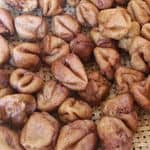 Adrem Cake first originated in Bantul regency, Yogyakarta. It is a simple cake made from rice flour, grated coconut and brown sugar.
Adrem Cake first originated in Bantul regency, Yogyakarta. It is a simple cake made from rice flour, grated coconut and brown sugar.
The brown sugar is melted first and then mixed in with the rice flour and grated coconut. Once the dough is done, it is cut into tiny pieces.
Read more: Traditional Cakes in Indonesia
They are then fried in hot oil until the colour becomes golden brownish. When they are fried, bamboo sticks are clipped between the dough to make a unique shape in the middle.
11. Gudeg
 Gudeg is a very popular traditional food from Yogyakarta. It’s a dish made with jack fruit that has not fully riped yet.
Gudeg is a very popular traditional food from Yogyakarta. It’s a dish made with jack fruit that has not fully riped yet.
The jackfruit is boiled with coconut milk and a little bit of brown sugar. Spices such as garlic, bay leaves, shallot, teak leaves, galangal and coriander seed are usually added to the dish.
Also read: Rice Production in Indonesia
Gudeg is usually served with warm steamed rice, chicken, boiled egg, tempeh or tofu.
12. Hibiscus Flower Soup
 This soup is a local delicacy of Yogyakarta. It is called as Sup Kembang Waru in Indonesia. Unfortunately, this dish is a rare one. It is only served during special occasions such as a wedding.
This soup is a local delicacy of Yogyakarta. It is called as Sup Kembang Waru in Indonesia. Unfortunately, this dish is a rare one. It is only served during special occasions such as a wedding.
Also read: Dining Etiquette in Indonesia
Apparently, one can taste this dish at Beringharjo Market. Hibiscus Flower Soup is a soup consisting of vegetables such as carrots, beans, shredded meat or chicken feet.
The one special component is a dumpling filled with chicken. The dumpling resembles the shape of a hibiscus flower.
13. Tempe Benguk
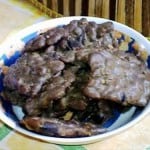 Tempe Benguk is a traditional tempeh dish. Tempe Benguk is made in the same way as making tempeh except that the ingredient is different.
Tempe Benguk is a traditional tempeh dish. Tempe Benguk is made in the same way as making tempeh except that the ingredient is different.
Ordinary tempeh is made from soy beans while Tempe Bengkuk is made from sword bean. When Tempe Bengkuk is made, it is often cooked with thick coconut milk.
The texture becomes soft but crunchy at the same time. Tempe Bengkuk is locally from Kulon Progo regency in Yogyakarta.
14. Geblek
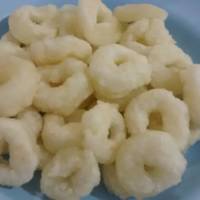 Geblek is another traditional food that originated from Kulon Progo regency, Yogyakarta. Geblek is a type of food made from tapioca flour. The shape of Geblek is unique. It is round but it also resembles the shape of the number 8.
Geblek is another traditional food that originated from Kulon Progo regency, Yogyakarta. Geblek is a type of food made from tapioca flour. The shape of Geblek is unique. It is round but it also resembles the shape of the number 8.
The main ingredient is garlic. It is added into the flour to give it taste. The texture inside is chewy but when it is already fried, it becomes crunchy on the outside.
Geblek is often eaten with peanut sauce. Geblek can be bought in shops. It is also sold in the form of dough so you can fry it by yourself at home. (Also read: Sundanese Cuisine)
15. Gethuk
 The next traditional food is called Gethuk. Gethuk is a popular dish in Yogyakarta. It is so popular that it is also sold in other cities in Indonesia.
The next traditional food is called Gethuk. Gethuk is a popular dish in Yogyakarta. It is so popular that it is also sold in other cities in Indonesia.
Gethuk is made from yam or taro. The yam or taro is steamed until it becomes soft. Once that is done, the yam or taro is pounded. (Read: Tipping Etiquette in Indonesia)
Sugar is added to give it a sweet flavour. Gethuk is usually served with grated coconut. People would often sell Gethuk using carts. The carts is moved around manually around a neighbourhood.
Read more: Traditional Balinese Breakfast
Others (16-25)
There are also more food that you should know about. Below is an additional list of traditional food of Yogyakarta:
- Tengklek Gajah: Gajah in Indonesia means elephant. However, this is not a dish that serves elephant meat. It just means the portion of the food is big. This dish serves very soft goat meat with its bones intact.
- Soto Kadipiro: Soto Kadipiro is a typical soto meal served with shredded chicken, herbs, vegetables and a secret combination of spices. What makes this dish special is that it has been around since the year of 1921.
- Peyek Tumpuk: Peyek Tumpuk originated from Bantul regency, Yogyakarta. This dish is made from rice flour mixed with peanuts. They are then fried until they turn golden brown and crisp.
- Mie Lethek: Mie Lethek is also a local food of Bantul regency. Mie Lethek is noodle made from dried cassava and tapioca flour. The noodle is perfectly paired with chicken or duck eggs.
- Mangut Lele: Mangut Lele is a dish consisting of catfish. The catfish is slathered with pounded garlic, scallion, ginger, chili, turmeric and galangal. The fish is not fried but grilled with bamboos.
- Sate Kere: Sate Kere is a traditional satay made from the lard of a cow. The lard is given a mixture of spices and grilled like any typical satay.
- Beringharjo Fried Rice: Beringharjo fried rice is often said to involve culinary taste from Java and Chinese. The fried rice is a typical fried rice but with a lot of soy sauce and garlic.
- Sego Abang Lombok Ijo: This dish literally means red rice with green chili. The dish is eaten with fried chicken, tempeh, tofu, gudeg or fried meat.
- Sate Buntel: Sate Buntel is a dish that has been around Yogyakarta ever since 1948. Lim Hwa Youe invented it. The meat of the satay is put into the stick and then covered with the fat of goat.
- Sate Klatak: Sate Klatak is satay that is made from goat meat. A lot of spices are added to the meat. The meat is then put into a metal stick, not a traditional bamboo stick. The metal stick is said to help generate heat so the meat will cook perfectly.
Also read:
All of this traditional food in Yogyakarta is worth the try. Some are available in shops and you can buy them for family, friends or yourself.